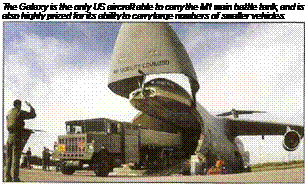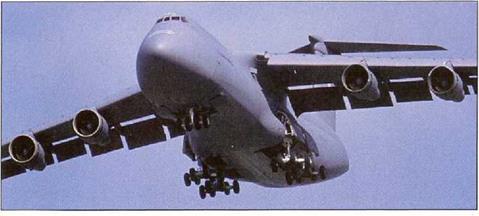Lockheed C-5 Galaxy
|
|
T |
he Lockheed C-5 Galaxy heavy logistics transport originated from a 19S3 USAF CX-HLS (Cargo Experimental-Heavy Logistics System! recuirement for a capability to carry a 113400-kg (250,000-loJ payload ever 4828 km (3,000 miles) without air refuelling. The resulting design incorporates a high-wing. T-tailed configuration, powered by four urtderwrng codded TF39 turbofans. Key to the С-5’s mission is its cavernous interior and ‘roll on/roL off’ cargo loading capability, with access to the vast cargo bay at both front end rear via an upward-lifting visor nose and standard rear clamshell doors. The C-5A first flew cn 30 June 1968 and operational C-5s were delivered between 17 December 1969 and May 1973 T. ne C-5A suffered initially from wing crack problems anc infamous cost overruns, but has served well since then and is an irreplaceable asset for the US At Force’s Air Mobility Commard. To extend their service lives, 77 C-5As underwent a re-winging programme from 1981 to ‘987.
In the mic-1980s, the production line was reopened to meet an urgert USAF demand for additional heavy airlift capacity. Fifty C-5B aircraft were built, essentially similar to the C-5A, but incorporating numerous mocifications and improve
ments resu ting from operations with the C-5A. The C-5B model dispensed with the C-5A’$ complex crosswind main landing gear ard introduces an iinproved AFCS (automated flig. nt control system). The first production C-5B was delivered on 8 January 1986 and Deliveries were completed by 1989. A further variant is the secretive C-5C, (two converted! which is optimised for carrying satellites and space equipment, The C-5C has a bulged rear cargo door and a sealed nose door.
Typical C-5 loads include two ІУІ1А1 Abrams MBTs, 16%-ton trucks, 10 LAV-25S, or a CH-47. Although not usually assigned airdrop duties, the Galaxy can also drop paratroopers. С-БА/Bs serve with the USAF’s AMC, AFRC, and the ANG. Ga axies have served in airlifts supporting US operations in Vietnam, Israel (October 1973 Wad and Deser: Shield/ Storm (1990-91), during which they flew 42 per cent of cargo and 18.6 per cent of passenger missions.
Under the recently announced C-5 Reliability Enhancement and Re-engining Program (RtRP), the Galaxy wil be refitted with General Electric CF6-80C2 engres and a modernised cockpit. All 126 aircraft will be upgraded between 2005 ard 2014, possibly receiving the C-5D designation.
 Specification: Lockheed C-5B Galaxy Powerplant: ‘o ur 191.27-kN (43,D0D-lb) General Electric TF33-GE-1C tirbofars Dimensions: wing span 6/.8B rr (222 ft 8/ ini; length /5,54 m 1247 ft 10 in); heigh" 19 35 m [65 ft 1 ik in)
Specification: Lockheed C-5B Galaxy Powerplant: ‘o ur 191.27-kN (43,D0D-lb) General Electric TF33-GE-1C tirbofars Dimensions: wing span 6/.8B rr (222 ft 8/ ini; length /5,54 m 1247 ft 10 in); heigh" 19 35 m [65 ft 1 ik in)
Weights: operating empty 169843 <g (374,000 lb); maximum payload 115387 kg (251,000 Ibl; maximum take-off 379657 kg (837.000 Ibl Performance: max level speed at 7620 m (25.000 (1) 913 knit; maximum cruising speed between 888 and 908 krm (552 and 564 mph), [571 mph); maximum rate of climb at sea leve 525 m (1,725 ft) per minute; service ceding 10595 m [35,750 ft); range 10411 km (5/69 miles] with maximum fuel












